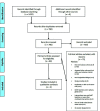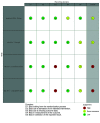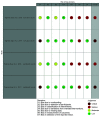Oral health effects of botulinum toxin treatment for drooling: a systematic review
- PMID: 33340083
- PMCID: PMC7980293
- DOI: 10.4317/medoral.24101
Oral health effects of botulinum toxin treatment for drooling: a systematic review
Abstract
Background: Drooling is a major morbidity in several neurological diseases. Intraglandular botulinum neurotoxin (BoNT) injections have been used to manage this condition. However, by decreasing salivary flow, BoNT injections may result in an increased risk of caries and other oral adverse effects. In this study, we aimed to assess whether, in patients with drooling, intraglandular BoNT injections are associated with increased dental caries development, modifications on salivary composition (oral pH, buffering capacity and osmolality) and cariogenic bacterial load.
Material and methods: We performed a systematic review, searching PubMed, CENTRAL, Web of Science, and Scopus for all experimental and observational studies reporting on adverse effects of intraglandular BoNT injections in patients with drooling. Primary study selection, quality assessment, and data extraction were independently performed by two researchers. No studies were excluded based on their language, publication status or date of publication. Studies' quality was based on revised Cochrane Risk of Bias tools. Meta-analysis was not performed.
Results: We retrieved 1025 studies, of which 5 were included. Two studies were two randomized controlled trials and three quasi-experimental studies. None of the included studies found BoNT injections to be associated with dental caries development or with significant reductions in oral pH. One of the included primary studies even observed an increase in salivary buffer capacity. One study found an increase in Lactobacilli counts. As for the risk of bias, two studies were classified as having a critical risk, two as high risk and one as having some concerns.
Conclusions: Currently, there is no evidence that, in patients with drooling, BoNT injections associate with increased risk of dental caries or disturbances in oral pH or salivary buffering capacity. However, the included primary studies had important limitations and differences in their methodologies.
Conflict of interest statement
Conflicts of interest The authors declared no conflicts of interest with respect to the research, authorship, and/or publication of this article.
Figures
Similar articles
-
The effectiveness and safety of botulinum toxin injections for the treatment of sialorrhea with Parkinson's disease: a systematic review and meta-analysis.BMC Pharmacol Toxicol. 2023 Oct 12;24(1):52. doi: 10.1186/s40360-023-00694-7. BMC Pharmacol Toxicol. 2023. PMID: 37828600 Free PMC article.
-
Comparing the evidence for botulinum neurotoxin injections in paediatric anterior drooling: a scoping review.Eur J Pediatr. 2024 Jan;183(1):83-93. doi: 10.1007/s00431-023-05309-1. Epub 2023 Nov 4. Eur J Pediatr. 2024. PMID: 37924348 Free PMC article.
-
Effect of botulinum toxin in the treatment of drooling: a controlled clinical trial.Pediatrics. 2004 Sep;114(3):620-7. doi: 10.1542/peds.2003-1104-L. Pediatrics. 2004. PMID: 15342830 Clinical Trial.
-
Effects of salivary gland botulinum Toxin-A on drooling and respiratory morbidity in children with neurological dysfunction.Int J Pediatr Otorhinolaryngol. 2019 Sep;124:124-128. doi: 10.1016/j.ijporl.2019.05.044. Epub 2019 Jun 4. Int J Pediatr Otorhinolaryngol. 2019. PMID: 31185343
-
Does Botulinum neurotoxin type A treatment for sialorrhea change oral health?Clin Oral Investig. 2017 Apr;21(3):795-800. doi: 10.1007/s00784-016-1826-z. Epub 2016 Apr 26. Clin Oral Investig. 2017. PMID: 27114092
Cited by
-
Recommendations for a paradigm shift in approach to increase the recognition and treatment of sialorrhea in Parkinson's disease.Clin Park Relat Disord. 2023 Oct 11;9:100223. doi: 10.1016/j.prdoa.2023.100223. eCollection 2023. Clin Park Relat Disord. 2023. PMID: 38021341 Free PMC article. Review.
-
Botulinum Toxin, a Drug with Potential Interest for Dentists-An Introduction.Toxins (Basel). 2022 Sep 25;14(10):667. doi: 10.3390/toxins14100667. Toxins (Basel). 2022. PMID: 36287936 Free PMC article. Review.
References
-
- Varley LP, Denieffe S, O'Gorman C, Murphy A, Gooney M. A systematic review of noninvasive and invasive sialorrhoea management. J Clin Nurs. 2019;28:4190–206. - PubMed
-
- Abboud WA, Nadel S, Hassin-Baer S, Arad A, Dobriyan A, Yahalom R. Ultrasound-Guided Botulinum Toxin Injections into the Salivary Glands for the Treatment of Drooling. Isr Med Assoc J. 2019;2:116–9. - PubMed
-
- Taib BG, Williams SP, Sood S, Ung K, Nixon PP, Sharma R. Treatment of sialorrhoea with repeated ultrasound-guided injections of botulinum toxin A into the parotid and submandibular glands. Br J Oral Maxillofac Surg. 2019;57:442–8. - PubMed
Publication types
MeSH terms
Substances
LinkOut - more resources
Full Text Sources
Other Literature Sources
Medical
Research Materials





